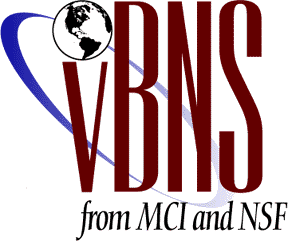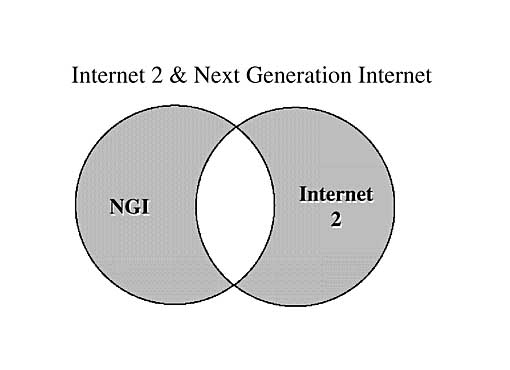
North American academic institutions, agencies of the US federal government, and leading computer and telecommunication companies are investing in high speed, private networks to support advanced real-time multimedia applications. The Internet 2 Project is a collaborative initiative among them, that aims to create a next-generation research and educational network. The project rose in response to the research institutions' frustration with what they see an overloaded commercial Internet backbone that is not developing fast enough to meet the rapidly evolving advanced communication needs of research, education, environmental monitoring, and health care.
Specific Goals
The three specific goals of the Internet 2 Project (also known as the Next Generation Internet) are:
In October of 1996 President Clinton announced his administration's incentive to the Next Generation Internet. The Next Generation Internet or NGI is a multi-agency Federal research and development program working to develop an advanced networking system similar to the current Internet but up to 1000 times faster. The network will connect at least 100 universities, Federal research institutions, and other corporate partners. The Next Generation Internet will allow federal agencies and research organizations the ability to transmit massive amounts of data to other institutions in real time. With this ability the research community of the United States will be able to communicate and network more efficiently than ever before. In addition, the Next Generation will aid in the research and development efforts of such government agencies as the defense, energy, health, and space departments.
Although the Internet2 project is a separate, privately funded initiative than the Next Generation Internet, they are seen as compatible and complementary projects. There are many ways in which the Internet2 and the Next Generation Internet will work together. The National Science Foundation is sponsoring many universities that use the Internet2. In this case, the NSF is allowing member Universities to use its vBNS as a backbone for connections. Those Universities are establishing GigaPoPs that employ additional technology transfer to other member organizations. Finally, Internet2 universities are developing many advanced networking technologies that are funded and eventually used by the government.
The Clinton administration has made continuous efforts to promote NGI and inform the public. President Clinton's 1998 State of the Union Address included reference to the Next Generation Internet and Vice President Gore recently addressed the nation in a presentation focussed solely on the Next Generation Internet and the Information Highway.
Specific ways in which the Federal NGI initiative and the university-led
Internet2 work together include:

Government Funding
The Clinton administration has requested that $300 million be allocated to specific government agencies over a three year period to aid in the implementation of the Next Generation Internet. This funding will be offset by a reallocation of defense and domestic technology funds. With this government investment will bring additional investment by universities and the private sector.
Below are the budget allocations in for government sectors slated to
work on NGI:
| Yearly Budgets |
|
|
|
|
|
|
| 1998 |
|
|
|
|
|
|
| 1999 |
|
|
|
|
|
|
Government Agencies
The following agencies will contribute skills, R&D, and respective networks to aid in the Next Generation initiative. With these government agencies providing their support and experience, NGI and Interet2 will operate with greater success. The following are specific agency offerings:
DARPA: Defense
Advances Research Projects Agency
DARPA?s main responsibilities in the implementation of NGI are: to
develop network growth engineering to put them in the hands of the research
community by providing the use of its network, the Defense Research and
Education Network (DREN), ensure that the technologies are available for
use in mission critical environments, and to create an infrastructure partnership
available for government and private use. The Department of Defense
will also offer it?s High Performance Computing Modernization Program (HPCMP)
and its constituent Defense Research and Engineering Network (DREN) in
the NGI. The main goals of the Department of Defense are to establish
gateway connectivity among DREN and select aggregation points and support
the access among NGI-connected sites and DREN sites through this gateway
connection.
NASA:
National Aeronautics and Space Administration
NASA has pledged to sponsor research and development in the new networking
technologies established by NGI. NASA will partner with member universities
and supply them with its advanced networking services, the National Research
Education Network (NREN). NASA sponsored research will focus on network
performance measurement networks interoperatability scaling, management,
and network security. They will offer networking capabilities that
have richer features, higher performance, and lower costs all in real time.
NIH/NLM:
National Institute of Health/National Library of Medicine
These two organizations will offer extensive experience in medical
research and health care applications
NIST:
National Institute of Standards and Technology
The NIST?s current responsibilities to coordinate continuous research
in advanced technologies, computer security, and conformance testing mesh
well with the goals of NGI. The NGI offers NIST an excellent opportunity
to continue its research in such areas and refine its research focus.
However its unique mission in this joint project is to support the U.S.
information technology industry by aiding in the commercialization and
establishment of infrastructure networking technologies developed in NGI.
NSF:
National Science Foundation
The National Science Foundation has experience in the development of
such networks, having played a prominent role in the first Internet.
The NSF is making a significant contribution in the Next Generation Internet
and will play another significant role in its establishment. In this
case, the NSF is fostering campus and industry networks that connect 100
leading research universities to its very high performance Backbone Network
Service (vBNS). Already, NSF has made more than 70 High Performance
Connections awards to Internet2 universities. NSF will work with
DARPA and NASA to support the integration of agencies and research universities.
In addition, NSF will lend its on-line, real time visualization set of
network transfers known as NLANR to member universities and the Internet2
Project.
DoE:
Department of Energy
The Department of Energy's Energy Sciences network will be offered
for connection to member universities. In addition, its long-term
experience in managing production and research network technology will
offer supreme management services. Although they will not be allocated
funds to aid in operation in 1998, the second year of implementation will
offer them $25 million for which to contribute their expertise.
In conclusion, the management of the NGI Program will be coordinated
within the framework of the National Science and Technology Council (NSTC).
The Large Scale Networking (LSN) Working Group is responsible for the implementation
strategy of the NGI. A small, integrated NGI Implementation Team
will take primary responsibility for implementing the approved plans under
the direction of the LSN Working Group. In particular the NGI Implementation
Team will:
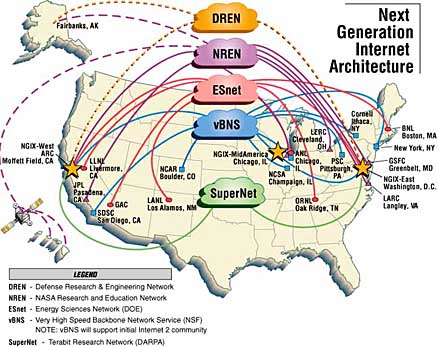
Application
vBNS
The Next Generation Internet will operate by connecting Internet2 universities
to the NSF?s very high performance Backbone Network Service (vBNS).
vBNS connectivity is a key part of NSF?s NGI program. The vBNS is
a nationwide network that supports high-performance, high-bandwidth applications
for research and education. It is a joint venture between MCI and
the NSF. Currently the NSF is working with MCI, using vBNS, to make
the current Internet faster and more efficient. The network links
five NSF supercomputer centers and will connect up to 100 research institutions.
The network is expected to be several steps ahead of commercially availability
networking.
Corporate Partners and Project Abilene
As the World Wide Web has become a household word, the realization of a faster, more accurate Internet is in the works. While work on the Next Generation Internet initiative brings high hopes to Washington nothing could be accomplished without the support of the nations forth coming corporate leaders in technological advancement. The University Corporation for Advanced Internet Development (UCAID) is a group formed to provide leadership and direction for and advanced networking community. UCAID devotes its effort to network research, technology transfer, and collaborative activities in fields related to Internet applications. UCAID is supported by over 175 organizations including the top Universities, non-profit organizations and technological and telecommunication corporations.
Currently the main project focused on by UCAID is project Abilene. Abilene is a high-performance network that will be the backbone of Internet2. It will use high-speed Sonet facilities and Internet Protocol (IP)-over-Sonet routers accessible to gigaPoPs in many locations throughout the nation supporting the Internet2 infrastructure. This will enable connected Universities and research labs to more efficiently develop advanced network services and applications.
Project Abilene is an integral part of the development of Internet2. It provides an effective interconnection among regional gigaPoPs pioneered by Internet2 Universities. Abilene is in essence used to test and support Internet2 issues such as quality of service, multicasting of voice, data, and video streams and other related topics. In addition, project Abilene will also focus on network research beyond Internet2. It will be a key enabler of the university?s community effort to collaborate with federal agencies on research and development of advanced network technologies while connecting to the existing federal networks like vBNS. This is important to the project because it compliments the Internet2 backbone network. Even though both provide advanced IP connectivity it is accomplished through different technologies. The multi-vendor, multi-network development is important to advancement as these technologies are moved out of the laboratories and put into use in the marketplace.
The long-range goals of Internet2 are to ensure that advancements and developments made are put to use in the broader global Internet. With the help of Qwest Communications, Cisco Systems and Nortel (Northern Telecom), the Abilene project will help meet the goals of Internet2. At the same time, Project Abilene will allow the entire networking community to benefit from the work now under way with the university community and federal agencies. By acting as a test bed for new designs for networking and by publishing the interfaces, which result from that work, Project Abilene will stimulate commercial activity built upon this pioneering work.
Qwest Communications
Qwest Communications International, Inc is a digital age communications
company that has built a high-capacity, fiber optical network stretching
for over 16, 000 miles from California to New York and many places in-between.
The network is able to provide the highest-quality video and voice connectivity
with security and reliability. It is designed to be the highest capacity
digital infrastructure in the world. This is why it is a desired
partner for the University Corporation for Advanced Internet Development?s
Project Abilene. With Qwest making its state of the art infrastructure
available to the project it will become the communication backbone of the
Internet2 and it should have no problem at that. The fiber optic
network has been designed with the capacity to transmit up to two terabits
per second (two trillion bits of multimedia per second). To put this
into perspective it is the same as transmitting the entire Library of Congress
in twenty seconds. This is more than any other communications network
available and the reason why Qwest is a main corporate partner for the
Internet 2. In addition to the incomprehensible transmission time
it also has a feature to protect against the loss of data. Using
the highest quality non-zero, dispersion shifted glass, the best transmission
technology and the advanced SONET ring architecture, Qwest is able to ensure
less than one bit of error in every quadrillion bits. This is the
same as losing one grain of sand from a twenty-mile beach. This has
set a New World standard for reliability and accuracy in data transmission.
On April 13, 1998 Qwest became the first company to upgrade the country?s communication infrastructure by activating the first coast to coast native Internet protocol network. This network is now able to serve over 125 cities in the U.S. or roughly 80 percent of the data and voice traffic. The system is designed with a bi-directional, line-switching OC 192 SONET ring architecture. This will offer a self-care system, which will automatically reroute the signal direction in the event of communication blocks such as a fiber cut. This is important to the agenda of Internet2 since many of its applications will require the most efficient, quick time response.
The next day (April 14, 1998) Qwest announced that it would be working in conjunction with UCAID to provide the backbone IP network for project Abilene. The project will have access to the Qwest Macro CapacitySM Fiber Network nationwide. The advanced network will enable researchers and educators to develop the applications crucial to the mission of higher education. The network will combine the Next Generation Internet achievements with those of the Internet2, as the two projects will work in conjunction to utilize the new sound powers of the fiber optic network.
Nortel (Northern Telecom)
Nortel is a major corporate partner for UCAID?s project Abilene. The business itself works with customers world wide to design and integrate communication products and advanced digital networks. Nortel is determined to cater to a new global communications industry and focuses on the shift to webtone. As a member of project Abilene, Nortel has strengthened its role in shaping a new more advanced Internet. The challenge to Nortel is to navigate through the changes that will come with the Internet2. Nortel contributes through its research and development. It spends two billion annually on research and development, which continues to help shape the nature of modern telecommunications. Nortel specializes in network and product architectures, network and services planning, system design, digital signal processing, compression technologies, speech recognition, high-speed electronics, optoelectronics and security and encryption.
On October 14, 1997 Northern Telecom announced its partnership with UCAID. As one of the corporate partners Nortel is recognized at the most senior level of participation. Nortel by itself will contribute in excess of one million dollars worth of equipment and grants to Internet2 institutions. A major donation it has already made is the OC-48 transport equipment. This has already been installed at MCNC in North Carolina. This equipment has been instrumental in the advancement of the regional Internet2 network and the high-speed gigaPOP architecture designed for the I2 connection. Another major donation Nortel has made and will continue to make in the future are research grants to UCAID member universities. The research will cover various proposed capabilities of Internet2 such as real-time multimedia services, traffic and congestion management, and mobile IP users.
Nortel?s presence in UCAID also supports the White House?s Next Generation Internet initiative, which includes the National Transport Optical Network (NTON). This is a high-speed optical network being tested in the San Francisco Bay Area. The purpose of this research is to basically test wavelength division multiplexing. This is a means to expand the bandwidths of optical networks. When the realization of optical networks is fully operational the next step will be to expand on the light speed with bandwidth. With Nortel focusing efforts on wavelength multiplexing presently the advancement technology will already be available and operable when faced with a need for a broader bandwidth in the future.
Cisco Systems Inc.
Cisco Systems Inc. is the worldwide leader in networking for the Internet. Cisco?s networking solutions allow people to access or transfer information with out regard to differences in time, place or type of computer system. This is done with end-to-end networking, which is a solution that provides common architecture and delivers consistent network service.
On April 9, 1997 Cisco announced its partnership with UCAID and
project Abilene. Cisco plans on donating in excess of one million
dollars to the Internet2 project and will help facilitate and coordinate
the networking development, deployment and operation. Cisco has formed
a new department called the Advanced Internet Initiatives Division.
The purpose of this division is to support not only the US Internet initiative
but the worldwide one as well. Through this program Cisco will lend
technical and operations assistance in the design and testing of advanced
networks. Cisco is persistent in its efforts to work with the researcher
and educators on advanced Internet initiatives. As work continues
Cisco is helping to expand the boundaries of internetworking.
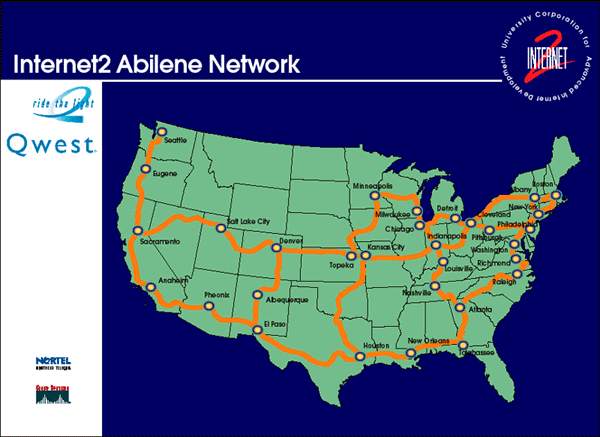
The Internet 2 Engineering group has established an overall architecture
for the I2 network. There are four technological components in the I2 model:
1. End-user applications and equipment.
2. High-speed campus networks.
3. GigaPoPs (gigabit capacity point of presence).
4. Internet 2 connections among GigaPoPs.
This design will be supported by the protocols for specifying and providing
connectivity, as well as network management tools, data, and organizations
to make it function.
Design
Fundamentally, the Internet 2 infrastructure should be designed to keep
a "common bearer service" for communication among network applications.
This "bearer service" is the basic information transport interface for
wide area communications. One of the greatest strengths of the existing
Internet is the ability of any node to communicate with any other node
in a compatible transport format. Therefore, the designers and engineers
should preserve this strength in Internet 2. This is the point of view
of the designers of the University Corporation for Advanced Internet Development
(UCAID).
As a result, the new I2-bearer service must be compatible with the
existing Internet. This is because the existing infrastructure will
continue to be the access path to all non-participants in Internet 2, as
well as to university members served by local Internet Service Providers
(ISPs). The common bearer service today is the Internet Protocol
(IP) version 4 (Ipv4). Internet 2 will arrange IP version 6 (IPv6).
All implementations must be backward compatible with IPv4 in order to be
compatible with the conventional Internet.
In addition to IPv6, Internet 2 must enable applications to specify
a network "Quality of Service" (QoS) along dimensions including transmission
speed, bounded delay and delay variance, and schedule. Meeting these
requirements is the design challenge undertaken by the project?s designers.
Fortunately, technologies intended to provide these capabilities have been
under development for several years, and initial production versions are
almost ready for serious testing in the field.
Additionally to these technologies, Internet 2 participants will require
the most cost-effective services. Unfortunately, advanced services
delivery and support systems will be very expensive. However, as
these services migrate into the commodity market there will be a complete
economic justification for their use. The engineering design for the Internet
2 Project infrastructure must enable end-user management of costs as well
as quality services.
The new and most important element in the architecture of the I2 is
the GigaPoP, through which it will gain access to the conventional Internet
services as well as advanced Internet 2 services. The GigaPoPs will then
join together to acquire and manage connectivity among themselves.
Potentially, there could be a wide range of services available at the GigaPoP,
limited only by the economics of the market and the absolute priority and
insulation of I2 services.
Even thouht the GigaPoPs are the most important componet of Internet
2, it has four major components:

The scope of Internet 2 applications requires a wide network to provide
services on an end-to-end basis. This implies significant upgrades to most
Internet 2 members? networks. Furthermore, the goals of the I2 project
cannot be achieved unless campus networks are upgraded to provide adequate
support for advanced applications. This means developing a campus network
in which applications requiring high-capacity, low-latency, low-jitter,
and multicast routing may flourish.
Many Internet 2 members already have plans to upgrade their campus
networks to I2 service levels. In general, such upgrades begin with
the campus backbone and a few sites on campus with special connections.
There are major immediate networking action items for I2 campuses: 1. Plan
and implement the necessary upgrades to campus network backbones and tail
circuits; 2. Collaborate with other nearby campuses to design, fund, and
implement a common GigaPoP; 3. Arrange for connectivity between the campus
and the GigaPoP; 4. Provide support for users whose applications require
Internet 2 connectivity.
GigaPoP Capacity
A GigaPoP is a regional network interconnection point, which provides
access to the cloud (inter-GigaPoP) network for several Internet 2 members.
An Internet 2 GigaPoP?s key function is to exchange traffic with specified
bandwidth and other Quality of Service attributes between connected Internet
2 member networks and the core Internet 2 network. Each GigaPoP is
expected to be managed by two or more universities. It is neither
practical nor possible to assign a single entity to run all GigaPoPs. GigaPoP
operation and coordination will be achieved through an organization, which
the developers called the Collective Entity (CE). Precedent for this
mode of operation was set in the conventional Internet.
Throughout the Collective Entity the GigaPoPs will collaborate to acquire
bandwidth and achieve their other goals. At the very least, the CE will
require a technical coordinator at the national level and a coordination
council that meets regularly. However, how these and other CE elements
are defined and organized will be an issue for the network management.
The network management must also decide on common standards for interconnecting
GigaPoPs and for the management protocols that will be exchanged in support
of advanced communications services. A GigaPoP is a secure and environmentally
conditioned location that houses a collection of communications equipment
and support hardware. The GigaPoPs will not serve as commercial transit
networks. Therefore, inter-GigaPoP links will only carry traffic among
Internet 2 sites. In the long run, GigaPoPs will serve customers beyond
communication among Internet 2 applications developers. In short, GigaPoPs
will link Internet 2 campus networks to other metropolitan area networks
in their communities; to research partners and other organizations with
which Internet 2 members wish to communicate; to other dedicated high-performance
wide area networks; and to other network services.
The engineers of the UCAID expect that each GigaPoP could serve five
to ten Internet 2 members. With even distribution this implies about a
dozen GigaPoPs. However, the designers of the different universities think
the number is unlikely to remain this low. This can happen because: first,
geography will strongly influence GigaPoP affiliations; second, in many
cases state-wide or regional initiatives will yield GigaPoPs serving both
Internet 2 and other needs; and third, some members for various reasons
will implement their own GigaPoP, increasing numbers still further.
An Internet 2 GigaPoP must do: the minimum things to satisfy the functional
and specifications of the Internet 2 network. It must also route only I2
traffic over Internet 2 inter-GigaPoP connections. Lastly, an I2 GigaPoP
may otherwise operate as simply as it chooses.
There are specified different types of GigaPoPs for different types
of members? requirements. This is because the engineers of the project
believe that some aggregation of members will involve complex situations
with significant traffic bound for and coming from diverse locations elsewhere,
while others will involve relatively simpler and smaller aggregations whose
drainage needs are modest. Given the rapidly growing numbers of I2
members and the prospective GigaPoP consortia, it may be necessary to have
some core switching nodes whose sole function is to connect GigaPoPs to
one another.
The GigaPoPs? managers are responsible for implementing any usage policies
referring to Internet 2. This means that the GigaPoPs? managers will decide
how and by whom the network will be used. The physical connectivity
to a GigaPoP does not imply either permission or ability to exchange traffic
with any other entity having a connection to that GigaPoP. Routing policies
of the GigaPoP will be used to enforce not only the Internet 2 rules, but
also the bilateral peering agreements that will control local traffic exchange
at GigaPoPs.
Determination of which institutions may connect to a particular GigaPoP
is up to the management of that GigaPoP. Determination of who can exchange
traffic at a GigaPoP will depend on bilateral peering agreements between
connections as well as local GigaPoP policy. However, only Internet 2 members
may exchange traffic via the Internet 2 "core" network, which links the
GigaPoPs together.
Costs for inter-GigaPoP connectivity are not yet known, and other GigaPoP
costs will vary with circumstances and services offered, so it is not possible
to say very much about requirements for cost accounting. Obviously, whatever
pricing mechanisms are selected must be technically supportable. GigaPoPs
must therefore save and share the usage statistics necessary for reasonable
Internet 2 cost allocations across members.
Connections and Sources
There will be two kinds of connections: the campus-to-GigaPoP and the
inter-GigaPoP. The campus-to-GigaPoP connections will have less traffic
than inter-GigaPoP connections. Therefore, the campus-to-GigaPoP connections
may also carry non-I2 traffic. The specifics of inter-GigaPoP connections
will depend on the bandwidth, QoS, and routing specifications they must
meet. While GigaPoPs will be required to provide certain kind of services,
the network managers will be encouraged but not required to support other
intercampus communications experiments. In particular, GigaPoPs may work
with attached campuses to broker connections based upon other communication
services.
The expected result is that the initial form of connectivity among
GigaPoPs will be the NSF vBNS network. Over time, this will be expanded
and enhanced by other forms of inter-GigaPoP connectivity. Other potential
linkages include: national network "clouds", such as Sprint's or IBM's;
a national network cloud created and operated by I2; and individual point-to-point
links between cooperating GigaPoPs.
The Internet 2 GigaPoPs will be constructed by consortia of universities,
which will have their own infrastructure to interconnect their GigaPoPs
and their members. In many cases consortium GigaPoPs will provide consortium-specific
GigaPoP services to members of their consortia before they are connected
to other GigaPoPs. In particular, the consortia may have already established
routing policies for traffic within and between themselves, as well as
between themselves and other network services, before they connect to each
other.
Educational Applications
Currently there are 135 universities researching and trying to implement
the Interent2.
The primary reason the universities began was to develop a new network
of applications in support of scientific research, distance education,
environmental monitoring, health care, and digital libraries. The
Internet2 would be able to download a 25-volume encyclopedia in one second.
Instructional Management System
IMS could greatly reduce the work of teachers. Currently teachers must find or create the learning materials, such as textbooks, software, instruments etc.. Teachers assign these materials to the students or must provide access to them. They must evaluate student learning and report the outcomes. Teachers must also define their own objectives for the students. In networked, distributed instructional environment, this process would be designed by teachers but managed by software. It can also be shared between teachers, students, and the information providers. IMS will permit distributed instructional modules to interpret with regard to such aspects as tracking of student progress, automated incorporation of modules into broader frameworks, collaborative interaction, and flow between modules.
Tele-immersion
Tele-immersion is an advances high-speed telecommunications systems to support collaboration applications. It would allow individuals at different locations to share a single virtual environment. All of the participants could share virtual data as if they were in the same room. It could reduce design cycles for manufacturing.
Tele-immersion would require higher bandwidth, low latency, and is very dependent of time being synchronized. Also, real images must be simulated with a realistic presence for tit to work.
Medical Applications
The Radiology Consultation Workstation is a multimedia medical imaging
workstation being developed for use in an electronic radiology environment,
utilizing a prototype Asynchronous Transfer Mode (ATM) telemedicine network.
Doctors will be able to consult utilizing high quality audio/video channels
and high -resolution medical. One use is a radiology consultation
workstation. It would try to provide remote consultation opportunities
for radiation oncologists and radiologists through the use of interactive
image analyses over ATM telemedicine networks.
It would allow doctors to fully interact during the identification
and delineation of lesions.
Environmental Applications
Advanced weather forecasting is another perk of Internet2. New
advanced Doppler weather radars may be added to update numerical weather
models. This will provide key additional data which is expected to
make rapid storm-scale modeling possible, thereby providing additional
warning of weather related hazards and for crisis management related to
these events. Data from advanced Doppler weather radars and satellites
will be aggregated and assimilated into high-resolution weather models
of the US. During the demonstration phase data from approximately
five radars will initially be aggregated and used to test and evaluate
various model formulations. As the technologies, models, and supporting
infrastructure evolve toward and eventual operational system, additional
radars may be added until the entire US is covered.
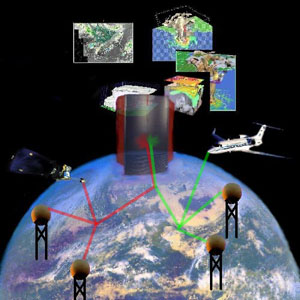
Virtual environments have been created and they enable scientists at
dispersed sites to study marine environments using real time control of
the simulation and multimodal presentation. Using Internet2, it is
more efficient than before because it incorporates runtime computational
sterring, interactive visualization, and data sonification and wide are
information dissemination to enable geographically distributed users to
interac5t multimodally in real time across a high-speed network.
It is run by a remote supercomputer by an oceanographer at his institution,
and can be observed by other researcher at their institutions.


